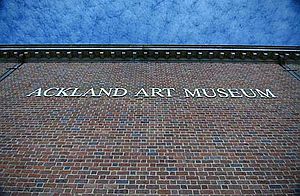Ackland Art Museum facts for kids
 |
|
| Lua error in Module:Location_map at line 420: attempt to index field 'wikibase' (a nil value). | |
| Established | September 20, 1958 |
|---|---|
| Location | Chapel Hill, North Carolina |
| Type | Art museum |
| Public transit access | Chapel Hill Transit |
The Ackland Art Museum is a cool place to see art. It's part of The University of North Carolina at Chapel Hill. A man named William Hayes Ackland wanted to create an art museum. He left money in his will to make it happen. The museum is located in Chapel Hill, North Carolina, right near the university campus.
It's free to visit the museum! They have many fun events. These events are about the art, the community, and the university.
Contents
The Museum's Story
William Hayes Ackland was from Tennessee. He loved collecting art. He wanted to use his money to start an art museum at a university in the South. In his will from 1936, he first thought about Duke University, UNC-Chapel Hill, and Rollins College in Florida. Duke was his first choice.
Later, Mr. Ackland visited Duke. He decided he only wanted Duke to get his money. He changed his will to remove UNC. He had once turned down going to Harvard College. Some people think he saw Duke as a similar top school in the South.
Mr. Ackland said Duke could have his money. But there was one condition: he wanted to be buried inside the new museum. When he passed away in 1940, Duke decided not to accept the gift. They felt it had "too many strings attached." This was interesting because three people from the Duke family were already buried on their campus.
A Legal Battle for the Museum
After Duke said no, Mr. Ackland's nieces and nephews went to court. They wanted to claim the money for themselves. Rollins College and The University of North Carolina at Chapel Hill also tried to get the money. They each wanted to build the art museum. The family took the case all the way to the United States Supreme Court. They argued that since only Duke was named in the will, the money should go to them if Duke refused.
Five years after the case started, Mr. Ackland's family lost in the Supreme Court. In 1947, a court decided that Mr. Ackland had liked Rollins more than UNC in his last days. So, Rollins was supposed to get the money.
However, the people in charge of Mr. Ackland's money thought UNC-Chapel Hill was a better choice. They looked at UNC's financial situation. They also considered how close it was to Duke. An appeal of the court's decision happened. In 1949, UNC was finally chosen to receive Mr. Ackland's gift. By then, the money had grown to $1.4 million! Mr. Ackland's remains were moved from Mount Olivet cemetery in Nashville. He was reburied at the museum at UNC, as he had wished.
What You Can See at the Museum
The Ackland Art Museum has a huge collection. It holds about 21,000 pieces of art! They are especially known for their Asian art. They also have many works of art on paper. This includes prints, photographs, and drawings.
The museum also has important European artworks. You can see art from the 1900s and today. There's also African art and pottery from North Carolina. Some famous artists whose work you might see include Eugène Delacroix, Albrecht Dürer, Jean-Honoré Fragonard, Käthe Kollwitz, Pablo Picasso, Salvador Dali, and Max Weber.
In 2024, the museum returned a painting called L'atelier du Maître / The Master's workshop. It was given back to the family of Armand Dorville. He was a French Jewish art collector whose family suffered greatly during the Holocaust.
Images for kids
-
Guercino, Assumption of the Virgin
-
Richard Westall's Sword of Damocles (1812)
-
Eugène Delacroix, Girl Seated in a Cemetery (1824)
-
Hiram Powers, Duff Greene, marble sculpture (1834-1837)
-
Eugène Delacroix, Cleopatra and the Peasant (1838)
See also
- List of places named after people







